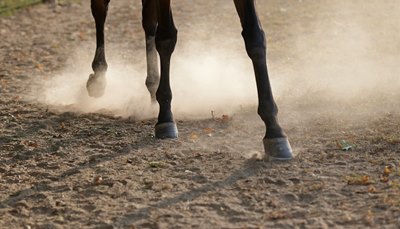Kentucky Horsemen Adjust to Drought-Like Conditions


Just one year ago, Lexington experienced a damp September with a record 10.42 inches of rainfall, but the weather in horse country has done a complete 180 this year as temperatures have hovered in the upper 80s and into the 90s with hardly a drop of rain.
Kentucky horsemen have been keeping a close watch on the horses throughout the dry spell, which is not yet considered a drought. The Lexington Herald-Leader reported Lexington is on track to see its driest September since 2010 when the city saw barely a half-inch of rain. And October is typically the area's driest month.
The dry spell followed steady rain during the first half of the year, as farm managers keep an eye on the changing conditions and adjust. Three Chimneys Farm COO Chris Baker noted the weather difference is an about-face for both humans and horses, adding the farm is making sure ample water is supplied, additional hay is thrown in the pastures, and fans are on while the horses are inside.
"We're watching closely, we're taking care. Some of the worst days, we're going around with a water wagon and putting some cool water on mares to help them deal with the hottest hot days," Baker said. "But the single biggest change is probably the amount of hay we've got on offer so that they can maintain body condition in the face of these dry conditions that have greatly reduced the amount of forage available."

Lee Hall, vice president of Lexington's Hallway Feeds, said horses are more apt to maintain their body condition in hot, dry weather versus wet pastures as long as they are on a good-quality feed program and have adequate forage. He said Hallway Feeds has been discussing weather management with clients, wanting people to make sure horses have an ample amount of clean water and supplemental hay when outside with the grass drying out in order to prevent digestive problems.
"We want them to have access to good, high-quality hay so they'll consume as much forage as possible," Hall said. "That will encourage water intake, that will keep the pipes working right as you well know. That will keep things moving regularly.
"We also suggest that hay and water are fairly close together so if horses are trying to stay cool and are not as active as they might be in less heat, then there's water closely available to their hay source if they're outside. Or if they're in the stall, that's a little easier to do.
"Also making sure that salt is available, making sure that you have free-choice salt blocks or loose salt, however you prefer to feed it. Make sure that's available outdoors or inside if the horses are spending some time in the stall, that they're both available."
Mulholland Springs co-owner and general manager John Henry Mulholland said in addition to keeping fans on the horses while inside and giving them electrolytes on the hottest days, the farm team has been rotating the pastures, which have been waiting for rain since being seeded in the past month.
"We've rotated fields and let some other fields rest for a month or so," Mulholland said. "Hopefully, we'll get a little rain this fall and some of the grass will come up."
Mulholland also noted the lack of rain has created dusty conditions, which has left some foals coughing.
"It's just so dusty. It's getting in their lungs and they're coughing. The foals, especially the weaned foals—the ones that we've just weaned—their immune systems are a little compromised, so we've been watching over them the most," said Mulholland, who also observed the dust affecting people the same way throughout the Keeneland September Yearling Sale.
While the horses are monitored, Mulholland added that the mares and yearlings on the farm appear to be handling the weather well to this point.
In addition to rain, cooler temperatures are also hoped for as the calendar moves into the fall season, with Sept. 23 listed as the official first day of autumn. During the first weeks of September temperatures hung in the 90s with Sept. 10 reaching 100.
"A break in the temperature would be nice," Mulholland said. "That's the worst between the coughing and the dust and all that, and then the heat is never good on the foals. That's what can lead to the Rhodococcus and the pneumonia, is all the heat. That's why the foals get sick when the temperature goes up. Hopefully with the temperature drop, maybe that will help some."

Baker said Three Chimneys horses also have been in good shape despite the conditions.
"Some of our layups seem to be a little more affected by the heat. We've kept them in longer in the day before putting them out for their overnight turnout, that kind of thing," Baker said. "We're not seeing our horses really struggling with it too badly. We're fortunate."
At Churchill Downs, where racing continues through Sept. 29, track superintendent Jamie Richardson said the September meet normally sees a reduction in water use, but that hasn't been the case this year because of the conditions.
"Normally, we are backing off. We are probably putting upwards of 100,000 gallons a day on it. Normally in September, it's not 90-plus degrees, either."
According to the National Weather Service, the most rain in sight for the Lexington area right now is a 30% chance Monday, the first day of fall.
"The spigot is on or the spigot is off," Baker said. "It appears to be off right now."
